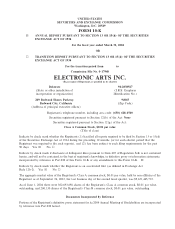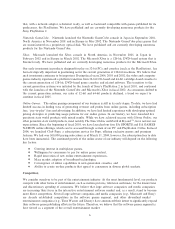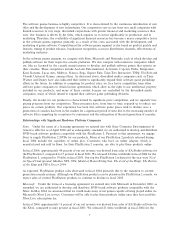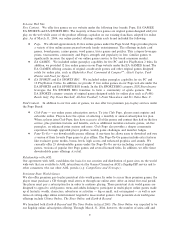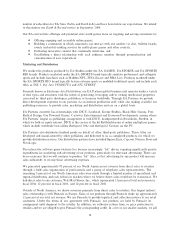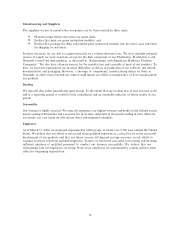Electronic Arts 2004 Annual Report Download - page 22
Download and view the complete annual report
Please find page 22 of the 2004 Electronic Arts annual report below. You can navigate through the pages in the report by either clicking on the pages listed below, or by using the keyword search tool below to find specific information within the annual report.The software games business is highly competitive. It is characterized by the continuous introduction of new
titles and the development of new technologies. Our competitors vary in size from very small companies with
limited resources to very large, diversiÑed corporations with greater Ñnancial and marketing resources than
ours. Our business is driven by hit titles, which requires us to invest signiÑcantly in production and in
marketing. Therefore, the availability of signiÑcant Ñnancial resources has become a major competitive factor
in the software games segment, primarily as a result of the costs associated with the development and
marketing of game software. Competition in the software games segment is also based on product quality and
features, timing of product releases, brand-name recognition, access to distribution channels, eÅectiveness of
marketing and price.
In the software games segment, we compete with Sony, Microsoft and Nintendo, each of which develop and
publish software for their respective console platforms. We also compete with numerous companies which
are, like us, licensed by the console manufacturers to develop and publish software games that operate on
their consoles. These competitors include Acclaim Entertainment, Activision, Capcom, Eidos, Infogrames,
Koei, Konami, Lucas Arts, Midway, Namco, Sega, Square Enix, Take-Two Interactive, THQ, Ubi Soft and
Vivendi Universal Games, among others. As discussed above, diversiÑed media companies such as Time
Warner and Disney have also indicated their intent to signiÑcantly expand their software game publishing
eÅorts in the future. In addition to competing for product sales, we face heavy competition from other
software game companies to obtain license agreements which allow us the right to use intellectual property
included in our products; and many of these content licenses are controlled by the diversiÑed media
companies, many of which intend to expand their software game publishing divisions.
Finally, the market for our products is characterized by signiÑcant price competition, and we regularly face
pricing pressures from our competitors. These pressures have, from time to time, required us to reduce our
prices on certain products. Our experience has been that software game prices tend to decline once a
generation of consoles has been in the market for a signiÑcant period of time due to the increasing number of
software titles competing for acceptance by consumers and the anticipation of the next generation of consoles.
Relationships with SigniÑcant Hardware Platform Companies
Sony. Under the terms of a licensing agreement we entered into with Sony Computer Entertainment of
America, eÅective as of April 2000 and as subsequently amended, we are authorized to develop and distribute
DVD-based software products compatible with the PlayStation 2. Pursuant to this agreement, we engage
Sony to supply PlayStation 2 DVDs for our products. Many of our PlayStation 2 products released during
Ñscal 2004 include the capability of online play. Customers who have an online adaptor, which is
manufactured and sold by Sony, for their PlayStation 2 consoles, are able to play these products online.
In Ñscal 2004, approximately 44 percent of our net revenue was derived from sales of EA Studio software for
the PlayStation 2, compared to 37 percent in Ñscal 2003. We released 24 titles worldwide in Ñscal 2004 for the
PlayStation 2, compared to 19 titles in Ñscal 2003. Our top Ñve PlayStation 2 releases for the year were Need
for Speed Underground, Madden NFL 2004, Medal of Honor Rising Sun, The Lord of the Rings; The Return
of the King and FIFA Soccer 2004.
As expected, PlayStation product sales decreased in Ñscal 2004 primarily due to the transition to current
generation console systems. Although our PlayStation products can be played on the PlayStation 2 console, we
expect sales of current PlayStation products to continue to decline in Ñscal 2005.
Microsoft. Under the terms of a licensing agreement we entered into with Microsoft in December 2000, as
amended, we are authorized to develop and distribute DVD-based software products compatible with the
Xbox. In May 2004, we announced that we would make many of our games capable of being played online via
Microsoft's Xbox Live service. Customers will be able to play these products online once they have paid the
Xbox Live subscription fee.
In Ñscal 2004, approximately 13 percent of our net revenue was derived from sales of EA Studio software for
the Xbox, compared to nine percent in Ñscal 2003. We released 21 titles worldwide in Ñscal 2004 for the
7






